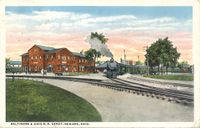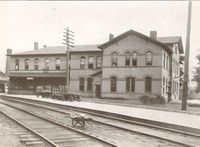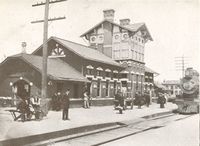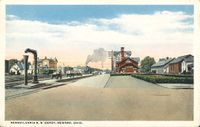Railroads
The railroad was a critical component to development and industrialization of Newark and Licking County in the late 19th and early 20th centuries. The companies that built, managed, and ran the railroads that connected the city and county to the wider world were an important facet of the region's economic, industrial, and everyday life for a century. Beginning as several shorter lines that became consolidated by Baltimore & Ohio and the "Panhandle," the rail lines would become a defining feature of life in Newark and Licking County in the late 19th and early 20th century.
Contents
The Sandusky, Mansfield, and Newark Railroad Company
The first railroad line built in Licking County in the early 1850s was part of a flurry of construction which would take place in Ohio from 1852 to 1855. [1] The Columbus and Lake Erie railroad, founded in March 1845, connected Newark to Mansfield in 1852 and was the city's first rail line, but the company could not survive as a single-line company. [2] Many small rail companies found financial stability in the mid-19th century elusive and tried to remedy their issues with revenue and cost through consolidation. In 1853, the Columbus and Lake Erie company merged with the Sandusky and Mansfield line, and the Huron and Oxford company, to form the Sandusky, Mansfield, and Newark rail company (SM&N). [3] This new business formation would stabilize the first rail lines in Licking County, yet the SM&N would face continued economic troubles and future consolidation. On February 13, 1869, the SM&N followed another local rail company, the Central Ohio Railroad Company, and merged with the growing B&O line. [4]
The Central Ohio Railroad Company
After four years of construction, the second rail line, that of the Central Ohio Railroad Company, arrived in Newark in 1854. The first leg connected Newark with Columbus with a future, planned route that would go from Columbus to Newark and Zanesville and then to a terminus at Bellaire on the Ohio River. The Central Ohio company faced financial strains in a fashion similar to the SM&N and would merge with B&O in 1866. [5]
The Baltimore and Ohio Railroad
The B&O Railroad was founded in 1829 with the goal of connecting the eastern United States with the growing western parts of the country. Combined with the two smaller lines in central Ohio, the B&O expanded its business in the area and would connect Licking County to Chicago and Washington D.C. under the same rail service. B&O laid a second track between Columbus and Newark in 1885-1887 and placed another line between Central City and Outville in 1906. B&O controlled three of the four lines that fed into Newark. [6]
B & O became a critical part of the economy of Newark and Licking County; the refinery in Heath and the American Bottle Company in Newark each needed large quantities of coal provided by the railroads. [7] Newark's location was beneficial thanks to a ready supply of coal from neighboring counties, and for water from the Licking River, both of which were critical to the maintenance of rail routes. [8] Not only did the rail company permit the fast flow of people and goods, but it was a leading employer in the city as well. The influence of he rail lines on the labor market can be discerned through the term often used to identify the east side of Newark - "B & O City." [9] The prevalence of railroaders in Newark led the establishment of a local chapter of the Locomotive Firemen's organization and the Order of Railway conductors. [10]
Newark was the terminal and headquarters of its division which encompassed 425 miles of railroad in 1928. The B & O rail depot in Newark was located at south First Street. The B&O freight station was on Clinton Street. The Division employed around 3000 workers at the time with a monthly payroll around $400,000[11]
If Newark was the meeting point of industry and rail in Licking County, then Avondale House, the resort at Buckeye Lake, was the confluence of passengers and luxury in the area; this line, known as the Straitsville Line or the "Shawnee Dinky," had four trains that possessed fine passenger coaches to deliver vacationers to the station at Buckeye Lake. [12]
The B&O Railroad ceased to exist as a distinct company after a series of mergers with other rail corporations that culminated in the merger with CSX corporation in 1997.
Pittsburgh, Columbus, and Cincinnati Railroad
The Pittsburgh, Columbus, an Cincinnati Railroad, called the "Panhandle" route, was the last railway line to come to Newark. Called the "Panhandle" because of its path along the thin. Northern panhandle neck of West Virginia, the line became consolidated under the Pennsylvania Railroad Company. [13]. The Columbus and Newark Division ("C&N") owned the railroad, but the land and track on which they ran remained in the possession of B & O. [14] The former depot of the "Panhandle" line still stands at 25 E Walnut Street in Newark as The Foundations building.
J.G.
References
- ↑ Brister, E., Centennial History of the City of Newark and Licking County, Ohio, (1909), 193
- ↑ Winegardner, C. (1997) A Historical Account B and O Rail Lines 1830—1989, 3.
- ↑ Brister, E., Centennial History of the City of Newark and Licking County, Ohio, (1909), 194
- ↑ Brister, E., Centennial History of the City of Newark and Licking County, Ohio, (1909) 195
- ↑ Brister, E., Centennial History of the City of Newark and Licking County, Ohio, (1909), 195
- ↑ Brister, E., Centennial History of the City of Newark and Licking County, Ohio, (1909), 196
- ↑ Winegardner, C., A Historical Account B and O Rail Lines 1830—1989, (1997), 40
- ↑ Winegardner, C., A Historical Account B and O Rail Lines 1830—1989, (1997), 38-39
- ↑ Winegardner, C., A Historical Account B and O Rail Lines 1830—1989, (1997), 39
- ↑ Brister, E., Centennial History of the City of Newark and Licking County, Ohio, (1909), 513
- ↑ Lewis, T., History Southeastern Ohio and the Muskingum Valley, Vol. II, (1928), 148-149
- ↑ Winegardner, C., A Historical Account B and O Rail Lines 1830—1989, (1997), 47
- ↑ Brister, E., Centennial History of the City of Newark and Licking County, Ohio, (1909), 197
- ↑ Winegardner, C., A Historical Account B and O Rail Lines 1830—1989, (1997) 38



